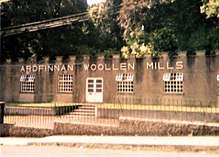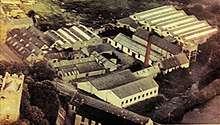Ardfinnan Woollen Mills
Ardfinnan Woollen Mills was a former wool mill, trading under messrs Mulcahy-Redmond and Co. Ltd. and located in the Suir Valley at the village of Ardfinnan, County Tipperary, Ireland. Founded in 1869, it manufactured woollen and worsted cloth, specialising in tweed and suitings for the tailoring trade. It briefly produced clothing for motorists, while later in its history turning to off-the-peg suits it became noted as the only firm in the Republic of Ireland completing all processes of clothing manufacture. A leading industry in Irish textiles, it closed in 1973 with the loss of over 200 jobs.

History
Early history
In 1867 J. Mulcahy from County Cork, who had knowledge in the wool trade, proposed to establish a woollen mill at Ardfinnan with the help of his investing friend J. Redmond. On the site of a former corn mill which had been in existence since before the early 17th century, it was built in 1869 beside the historic river crossing point at Ardfinnan bridge on Barrack Street, underneath Ardfinnan Castle.[1] The River Suir powered wool spinning machinery in a four-story building via a water turbine and was utilised for the washing and dying processes of the locally sheared wool, produced by sheep in the surrounding Galtee and Knockmealdown mountains. Buildings were also constructed for carding, weaving, finishing, as well as an office building and the process of 'tentering' was performed at the banks of the Suir on the village green. It was among only two such industries in Munster to employ a water turbine as a source of power at this time, those being Ashgrove Woollen Mills and Kerry Woollen Mills.[2] They primarily produced tweed blankets which quickly gained a reputation for their fine quality and variety. Saxony and cheviot cloth was primarily produced as their suitings and overcoatings.
In 1881 the main four-story mill building burnt down along with Mr. Mulcahy's dwelling, due to a large fire apparently caused by a lack of oil application to a crank shaft which connected to the mill's water wheel, but production was rectified by 1882 with the completion of smaller replacement two storey buildings.[3] With many hands thrown out of employment after the incident, numbers were reduced to 100 at the mill. Rows of cottages were built by the company to house its workforce, of which had a large influence on the growth of the village and later Ardfinnan GAA as the men often played football on the green opposite the mill after a days work.[4] Electricity generated by the mill's water turbine was later provided to a total of 14 homes in Ardfinnan and all of its electric street lights until the ESB introduced the Rural Electrification Scheme which took over the supply in January 1953.[5]
Car coat
.png)
With two of J. Mulcahy's sons now involved in his business by the turn of the century, they began manufacturing a new woollen cloth which innovatively combined warmth with a waterproof-breathable functionality. Thus, Mulcahy, Redmond & Co. was selected to represent the Irish Woollen Industry along with 12 other firms at the Cork International Exhibition of 1902. Along with other woollen goods, their display showcased coats and blankets which targeted the niche motoring scene of sporting elite and were crafted using their "Galtee Motor Frieze" cloth which would prove fit for purpose.[6] Claiming to be "the warmest cloth ever made for motoring coats" and blankets, it was a scientific combination of Irish frieze and mohair woven with pure merino. When dry, it would be slightly porous, therefore breathable and hygienic. When the outer surface became wet, the pores of the cloth closed due to its contraction and subsequently became entirely rainproof.[7] Supplied through the trade only, the firm has been deemed the first waterproof-breathable car coat manufacturer.
Throughout Great Britain and Ireland, the Galtee Motor Frieze became popular for bespoke tailored car coats, gaining widespread renown for the small firm, specifically after the success of the 1903 Gordon Bennett Cup. Royal patronage was received when HM King Edward VII visited Ardfinnan, with Queen Alexandra likely in 1904, where after a factory tour and having spent some time with the mill owners, commissioned the firm to make their Galtee cloth with his bespoke specifications. After being tailored into a fine coat on Saville Row (possibly at Henry Poole & Co), he expressed his delight for the quality of the versatile garment which he comfortably used on his motor drives. Irish motoring pioneer Richard J. Mecredy, remarked in 1906, "We have used one of these coats for several years, and find it perfect from every point of view", highlighting that it truly was waterproof not only after continuous use, but also when exposed to a water hose.[8] For inclement weather conditions on the road, the coats were superior in their multi-purpose functionality to either fur coats, Mackintosh or Burberry raincoats. Galtee Cloth can be seen as a predecessor to the cotton Grenfell Cloth, created in 1923 for similar, yet harsher weather conditions.
1914 - 1960s

The British War Office made large contracts with Mulcahy-Redmond during the First and Second World War to produce khaki serge for military uniforms.[9] Despite large success, some war contracts were turned down due to the still relatively small size of the mill. The 6th Marquess of Waterford, Lord Henry Beresford had overhauled his successful woollen mill at Kilmacthomas with first-rate machinery in 1910, only to soon die in 1911 and after which the family mill was sold to Stevenson Brothers of Staffordshire, England, who closed the mill and transferred its machinery to Ardfinnan Woollen Mills in the 1920s. Now in its third generation of Mulcahy family ownership, this resulted in a large expanse of Mulcahy-Redmond on to the opposite side of Barrack Street and hugely increased productivity. With the ending of their military contracts after the Second World War, they established a Men's & Boy's ready-made clothing department employing over 70 workers, making Mulcahy-Redmond & Co. the only firm within the Republic of Ireland that was completing all stages of clothing manufacture, starting from locally sheared wool to a wearable garment. They later produced Ardfinnan Knitting Wool.
The mill was long distinguished throughout the British Isles for its quality of tweed cloth, as well as internationally, seen at the 1965 Leipzig Trade Fair when a gold medal was awarded for Ardfinnan tweed and subsequently large orders of it were requested from firms in Germany. They supplied the cloth to the U.S.A. since the mid-1950s, with large orders for Macy's Herald Square department store in New York for their made-to-measure clothing.
Closure
With up to 500 people now dependent on the mill, around 220 workers were left unemployed when the firm closed in early February 1973 due to a competitive disadvantage with the onslaught of cheaper imports, largely taking its toll with Ireland's admission to the EEC. This resulted in a large protest in the nearby town of Clonmel as promises by the Fianna Fail government to sustain the mill through financial aid were not followed through. Youghal Carpets was the only Irish industry to receive such financial aid.
The company's former Dublin offices were at Ardfinnan House, 17 Trinity Street, Dublin 2. The steel plate name Ardfinnan House remains on the building. Their United Kingdom branch was at Londonderry House, Chichester Street, Belfast.
References
- ↑ Journal of The Waterford & South-East of Ireland Archaeological Society, Volume VII, Harvey & Co. 1901
- ↑ Industrial Ireland 1750-1930: An Archaeology, Colin Rynne, Collins Press, 2006
- ↑ Exeter Times
- ↑ http://www.ardfinnan.tipperary.gaa.ie/club-executive/committees/history
- ↑ https://esbarchives.ie/2017/09/18/connecting-tipperary-to-the-national-grid/
- ↑ Cork International Exhibition 1902 The Illustrated Exhibitor, Wilson, Hartnell & Co., 1902
- ↑ Health's Highway, R.J. Mecredy, Yellon, Williams & Co. Ltd., 1909
- ↑ The Encyclopaedia of Motoring, R.J. Mecredy, Mecredy Percy & Co. 1906
- ↑ In a Time of War: Tipperary 1914-1918, John Dennehy, Merrion, 2013
Coordinates: 52°18′40″N 7°52′46″W / 52.311222°N 7.879583°W